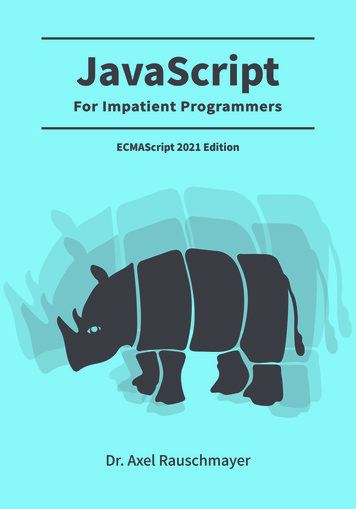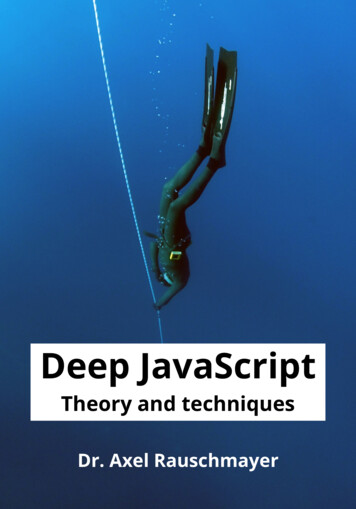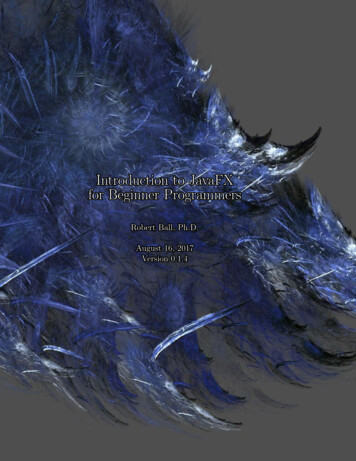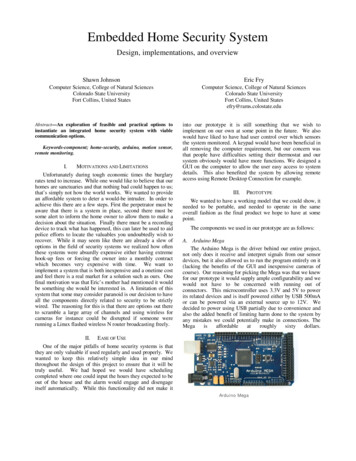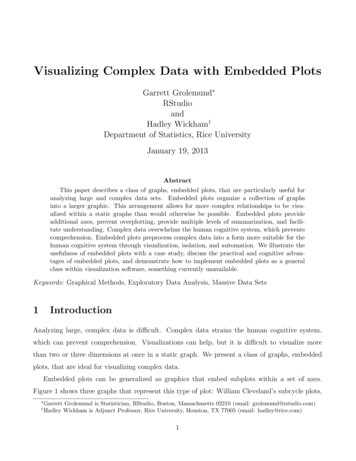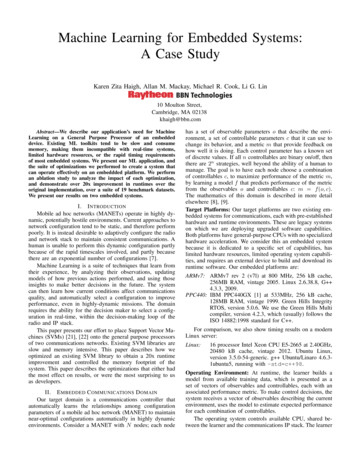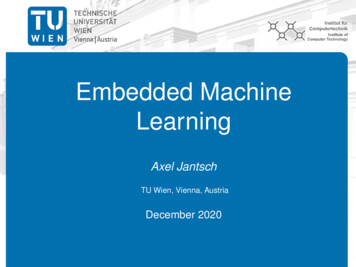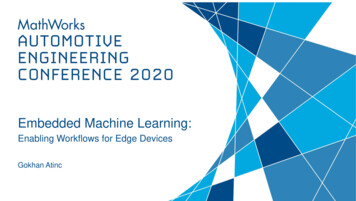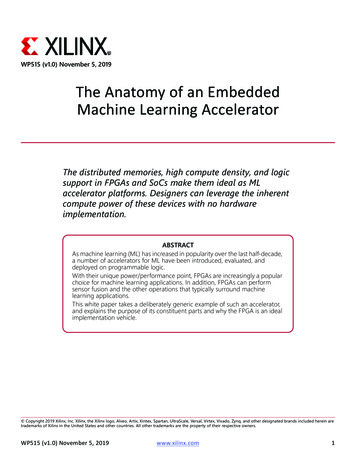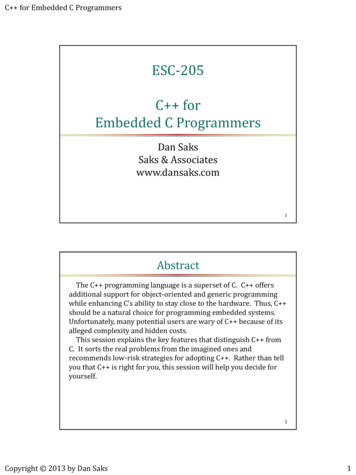
Transcription
C for Embedded C ProgrammersESC-205C forEmbedded C ProgrammersDan SaksSaks & Associateswww.dansaks.com1AbstractThe C programming language is a superset of C. C offersadditional support for object-oriented and generic programmingwhile enhancing C’s ability to stay close to the hardware. Thus, C should be a natural choice for programming embedded systems.Unfortunately, many potential users are wary of C because of itsalleged complexity and hidden costs.This session explains the key features that distinguish C fromC. It sorts the real problems from the imagined ones andrecommends low-risk strategies for adopting C . Rather than tellyou that C is right for you, this session will help you decide foryourself.2Copyright 2013 by Dan Saks1
C for Embedded C ProgrammersLegal Stuff These notes are Copyright 2013 by Dan Saks. If you have attended this seminar, then: You may make printed copies of these notes for your personaluse, as well as backup electronic copies as needed to protectagainst loss. You must preserve the copyright notices in each copy of thenotes that you make. You must treat all copies of the notes — electronic and printed— as a single book. That is, You may lend a copy to another person, as long as only oneperson at a time (including you) uses any of your copies. You may transfer ownership of your copies to anotherperson, as long as you destroy all copies you do not transfer.3More Legal Stuff If you have not attended this seminar, you may possess thesenotes provided you acquired them directly from Saks &Associates, or: You have acquired them, either directly or indirectly, fromsomeone who has (1) attended the seminar, or (2) paid toattend it at a conference, or (3) licensed the material from Saks& Associates. The person from whom you acquired the notes no longerpossesses any copies. If you would like permission to make additional copies of thesenotes, contact Saks & Associates.4Copyright 2013 by Dan Saks2
C for Embedded C ProgrammersDan SaksDan Saks is the president of Saks & Associates, which offerstraining and consulting in C and C and their use in developingembedded systems.Dan writes the “Programming Pointers” column for embedded.com online. He has written columns for several otherpublications including The C/C Users Journal, The C Report,Embedded Systems Design, and Software Development. WithThomas Plum, he wrote C Programming Guidelines, which won a1992 Computer Language Magazine Productivity Award.Dan served as secretary of the ANSI and ISO C Standardscommittees and as a member of the ANSI C Standards committee.More recently, he contributed to the CERT Secure C Coding Standardand the CERT Secure C Coding Standard.Dan is also a Microsoft MVP.56Copyright 2013 by Dan Saks3
C for Embedded C ProgrammersThe “ ” in C C is a programming language based on the C language. Like C, C is a general-purpose language. It’s not targeted toward any particular application domain. C retains C’s ability to deal efficiently with bits and bytes. C is particularly useful for embedded systems programming.7The “ ” in C C extends C with features that support large-scaleprogramming. These features help you organize large programs into smaller,simpler units. Compared to C, C lets you draw boundaries between subunits: more clearly more reliably no less efficiently (and sometimes even more efficiently)8Copyright 2013 by Dan Saks4
C for Embedded C ProgrammersThe “ ” in C One way to simplify building large systems is to build them fromlibraries of components: functions objects types You can produce better software in less time by: using components that others have written and tested, and returning the favor. That is, when feasible, package parts of your application(s)as components to share. C offers rich features for building libraries of components.9The “ ” in C C provides better support for large-scale development: object-oriented programming classes class derivation (inheritance) virtual functions (polymorphism) generic programming templates global name management namespaces C 11 (the current Standard) provides better support for lowlevel programming.10Copyright 2013 by Dan Saks5
C for Embedded C ProgrammersSaying “Hello” Here’s the classic “Hello, world” program in Standard C:// "Hello, world" in Standard C#include stdio.h int main() {printf("Hello, world\n");return 0;} This is also a Standard C program.11Saying “Hello” Here’s the same program in a distinctively C style:// "Hello, world" in Standard C #include iostream int main() {std::cout "Hello, world\n";return 0;} The bold italic text indicates the few places where the C program differs from the C program.12Copyright 2013 by Dan Saks6
C for Embedded C ProgrammersWhat’s Different? The latter program uses the standard header iostream insteadof stdio.h . iostream declares the Standard C Library’s input and outputcomponents. C provides iostream in addition to, not instead of, stdio.h .13What’s Really Different? This statement uses components declared in iostream to writethe value of "Hello, world\n" to standard output:std::cout "Hello, world\n"; The effect is essentially the same as calling:printf("Hello, world\n"); Most C programmers are already familiar with stdio.h . Using as an output operator isn’t obviously better than callingprintf. Why bother mastering a different library?14Copyright 2013 by Dan Saks7
C for Embedded C ProgrammersWhy Use a Different I/O Library? Again, C was designed to support large-scale programming. In a tiny program such as “Hello, world”, it’s hard to see anadvantage for iostream over stdio.h . In a big program, it’s much easier.15Why Use a Different I/O Library? Large programs deal with application-specific data formed fromthe primitive data types already in the language. For example, applications often handle data such as: calendar dates clock times physical devices (ports, timers, etc.) data collections (sequences, sets, etc.) and so on16Copyright 2013 by Dan Saks8
C for Embedded C ProgrammersUser-Defined Types In C, you might represent clock times as:struct clock time {unsigned char hrs, mins, secs;}; struct clock time t; That is, you’d invent a data type called clock time and declarevariables of that type representing clock times. A type such as clock time is a user-defined type. The user is you, the programmer.17User-Defined Types How do you write a clock time to a file? If clock time were a built-in type, stdio.h would provide aformat specifier for clock time. That is, you can write an integer i to file f using the %d format:fprintf(f, "The value is %d", i);// can do You should be able to write a clock time t using, say:fprintf(f, "The time is %t", t);// we wish Standard C doesn’t have a %t format, or anything like it.18Copyright 2013 by Dan Saks9
C for Embedded C ProgrammersUser-Defined Types stdio.h provides format specifiers only for built-in types. You can’t extend stdio.h to provide format specifiers for userdefined types. Not easily. Rather than use a single format specifier for clock time, youmust write something such as:fprintf(f, "The time is %2u:%02u:%02u", t.hrs, t.mins, t.secs); This isn’t nearly as easy to write as:fprintf(f, "The time is %t", t);19User-Defined Types In C, user-defined types don’t look like built-in types. They often introduce little details that complicate programs. In large programs, the little details add up to lots of complexity. As in C, C lets you define new types. But more than that C lets you define new types that look and act an awful lot likebuilt-in types. For example, C lets you extend the facilities of iostream towork for user-defined types such as clock time 20Copyright 2013 by Dan Saks10
C for Embedded C ProgrammersUser-Defined Types In particular, you can define a function named operator suchthat you can display a clock time t using:std::cout "The time is ";std::cout t;// (1)// (2) Both lines use the same notation for operands of different types:1) displays a value of built-in type (array of char)2) displays a value of user-defined type (clock time) You can even collapse (1) and (2) to just:std::cout "The time is " t;21Operator Overloading This statement makes clock time look like any other type:std::cout t;// (2) The compiler translates that statement into the function call:operator (std::cout, t); Despite the function’s odd-looking name, the call behaves justlike any other call. The operator function is an overloaded operator. Operator overloading is the ability to define new meanings foroperators.22Copyright 2013 by Dan Saks11
C for Embedded C ProgrammersAbstract Data Types Object-oriented design (OOD) and programming (OOP)emphasize building programs around data types. Those data types should be abstractions. If done properly, an abstract type: describes behavior (what an object of that type does) hides implementation details (how the object does whatever itdoes)23Primitive Data Types C provides: primitive types (arithmetic and pointer types) essentially the same as in C enumeration types (user-defined scalar types) better type checking than in C more powerful than in C aggregate types (arrays, structures and unions) lacking some features of C99, but otherwise generally more powerful than in C24Copyright 2013 by Dan Saks12
C for Embedded C ProgrammersClasses C doesn’t really have facilities for defining truly abstract types. C provides a general mechanism, classes, for specifying newtypes that are truly abstract. Classes are the essential feature that distinguishes C from C.25Classes and Objects An object is a unit of data storage that has the propertiesassociated with a class. To a great extent, saying:“An object is an instance of a class.”is just another way to say:“A variable is an instance of a type.”26Copyright 2013 by Dan Saks13
C for Embedded C ProgrammersCrafting New Data Types A central focus of object-oriented programming—and C programming—is crafting user-defined data types as classes. The basics of classes in C are not all that complicated. However, C is complicated, in large part because: C goes to great lengths to let you fashion user-defined typesthat look and act very much as if they were built in. The language was designed assuming: A user-defined type that looks and acts built-in should beeasier to use correctly, and harder to use incorrectly than itwould be otherwise.27Contrasting C with C The following example illustrates basic class concepts in C . It does so by contrasting a fairly traditional procedure-oriented Cprogram with an object-oriented C program. The example program is called xr. It’s a simple cross-reference generator. Posed as exercise 6-3 in Kernighan and Ritchie [1988]. Solved by Tondo and Gimpel [1989].28Copyright 2013 by Dan Saks14
C for Embedded C ProgrammersWhat the Program Does xr reads text from standard input. It writes a cross-reference listing to standard output. A typical line of output looks like:Jenny :word867 5309the numbers of the lineson which that word appears Even if “Jenny” actually appears more than once on any line, eachline appears only once in the output sequence of line numbersfor “Jenny”.29xr’s Data Structure xr builds the cross-reference as a unbalanced binary tree. Each node in the tree contains: the spelling of a word a sequence of line numbers on which that word appears in theinput The structure definition for the tree looks like:struct tnode {char *word;linklist *lines;tnode *left, *right;};30Copyright 2013 by Dan Saks15
C for Embedded C ProgrammersWatching a Tree Grow To visualize the data structure, suppose the input text containsthese lyrics from “I am the Walrus” by the Beatles [1967]:I am the eggman.They are the eggmen.I am the Walrus. In the ASCII collating sequence, uppercase letters are less thanlowercase letters. However, the following illustration assumes that the ordering iscase-insensitive 31Watching a Tree GrowI am the eggman.They are the eggmen.I am the Walrus.wordI(1)line number(s) Note that, in this and subsequent diagrams, every node contains: exactly one word, and at least one line number.32Copyright 2013 by Dan Saks16
C for Embedded C ProgrammersWatching a Tree GrowI am the eggman.They are the eggmen.I am the Walrus.I(1)am(1)33Watching a Tree GrowI am the eggman.They are the eggmen.I am the Walrus.I(1)am(1)the(1)34Copyright 2013 by Dan Saks17
C for Embedded C ProgrammersWatching a Tree GrowI am the eggman.They are the eggmen.I am the Walrus.I(1)am(1)the(1)eggman(1)35Watching a Tree GrowI am the eggman.They are the eggmen.I am the Walrus.I(1)am(1)the(1)eggman(1)They(2)36Copyright 2013 by Dan Saks18
C for Embedded C ProgrammersWatching a Tree GrowI am the eggman.They are the eggmen.I am the hing a Tree GrowI am the eggman.They are the eggmen.I am the Walrus.I(1)am(1)new line numberthe(1 2)eggman(1)They(2)are(2)38Copyright 2013 by Dan Saks19
C for Embedded C ProgrammersWatching a Tree GrowI am the eggman.They are the eggmen.I am the Walrus.I(1)am(1)the(1 2)eggman(1)are(2)They(2)eggmen(2)39Watching a Tree GrowI am the eggman.They are the eggmen.I am the Walrus.new line numbersI(1 3)am(1 3)the(1 2 3)eggman(1)are(2)They(2)eggmen(2)40Copyright 2013 by Dan Saks20
C for Embedded C ProgrammersWatching a Tree GrowI am the eggman.They are the eggmen.I am the Walrus.I(1 3)am(1 3)the(1 2 enting xr xr uses this function to read the input:int getword(char *word, int lim); Calling getword(w, m) reads (from standard input) the next wordor single non-alphabetic character. It copies at most the first m characters of that word or thatsingle character into w along with a null character, and returnsw[0].42Copyright 2013 by Dan Saks21
C for Embedded C ProgrammersImplementing xr xr uses this function to add words and line numbers to the tree:tnode *addtreex(tnode *p, char *w, int ln); Calling addtreex(p, w, n) adds word w and line number n to thetree whose root node is at address p (but only if they’re notalready in the tree). xr uses this function to display the results:void treexprint(tnode *p); Calling treexprint(p) writes (to standard output) the contentsof the tree whose root is at address p.43Implementing xr The main function is defined as:int main() {int linenum 1;tnode *root NULL;char word[MAXWORD];while (getword(word, MAXWORD) ! EOF)if (isalpha(word[0]))root addtreex(root, word, linenum);else if (word[0] '\n') linenum;treexprint(root);return 0;}44Copyright 2013 by Dan Saks22
C for Embedded C ProgrammersEvidence of Excess Complexity main’s job is to: keep track of the input line number determine when a word and its line number should go into thecross reference determine when to print the table main need not “know” how the cross-reference table isimplemented. In fact, “knowing” only makes main more complex than it has tobe.45Evidence of Excess Complexity Unfortunately, it’s evident from reading main that the crossreference table is a tree: The cross-reference object is declared as:tnode *root NULL; Each cross-referencing function has a parameter of typetnode *. Each cross-referencing function has treex in its name.46Copyright 2013 by Dan Saks23
C for Embedded C ProgrammersEvidence of Excess Complexity Suppose you later changed the program to use a different datastructure, say a hash table. This interface, particularly names using the word tree, would beinappropriate, if not downright confusing. Again, this evidence that the cross-reference table isimplemented as a tree adds conceptual complexity to main. Fortunately, that complexity is avoidable 47Encapsulating with Classes xr should be organized so that the implementation of the crossreference table is completely hidden from the main function. Encapsulate design decisions inside classes. You can define a cross reference table class that encapsulatesthe data representation and functionality of a cross-referencetable. Then implement xr using that class 48Copyright 2013 by Dan Saks24
C for Embedded C ProgrammersEncapsulating with Classes The class definition should look something like class cross reference table {public:cross reference table();void insert(char const *w, int ln);void put();private:struct tnode;tnode *root;};49Class Concepts A C class is a C structure, and then some. A class can contain data declarations, just like a C structure:class cross reference table {public:cross reference table();void insert(char const *w, int ln);void put();private:struct tnode;tnode *root;};50Copyright 2013 by Dan Saks25
C for Embedded C ProgrammersClass Concepts A class can also contain function declarations:class cross reference table {public:cross reference table();void insert(char const *w, int ln);void put();private:struct tnode;tnode *root;};51Class Concepts A class can also contain constant and type declarations. This class contains a type declaration:class cross reference table {public:cross reference table();void insert(char const *w, int ln);void put();private:struct tnode;tnode *root;};52Copyright 2013 by Dan Saks26
C for Embedded C ProgrammersClass Concepts The constants, data, functions and types declared in a class areits members. The data members specify the data representation for everyobject of that class. The member functions specify fundamental operations that aprogram can apply to objects of that class. The member constants and member types specify additionalproperties associated with the class. Why “data members” aren’t “member data” is a mystery.53Encapsulating with Classes A class can, and often does, contain access specifiers:class cross reference table {public:cross reference table();void insert(char const *w, int ln);void put();private:struct tnode;tnode *root;};54Copyright 2013 by Dan Saks27
C for Embedded C ProgrammersAccess Specifiers The public class members are: the interface to the services that a class provides to its users. accessible everywhere in the program that the class is visible. The private class members are: the implementation details behind the class interface. accessible only to other members of the same class. (This last statement is oversimplified, but sufficient for now.)55Encapsulating with Classes Here’s a more complete view of the header that define the class:// table.h – a cross reference table class class cross reference table {public:cross reference table();void insert(char const *w, int ln);void put();private:struct tnode;// tnode is incompletetnode *root;}; 56Copyright 2013 by Dan Saks28
C for Embedded C ProgrammersEncapsulating with Classes// table.h – a cross reference table class (continued)struct cross reference table::tnode {char *word;linklist *lines;tnode *left, *right;};// tnode is now completeinlinecross reference table::cross reference table():root (NULL) {} 57Encapsulating with Classes// table.h – a cross reference table class (continued)inline voidcross reference table::insert(char const *w, int ln) {root addtreex(root, w, ln);}inlinevoid cross reference table::put() {treexprint(root);}58Copyright 2013 by Dan Saks29
C for Embedded C Programmersmain Before Here’s the main function as it was originally:int main() {int linenum 1;tnode *root NULL;char word[MAXWORD];while (getword(word, MAXWORD) ! EOF)if (isalpha(word[0]))root addtreex(root, word, linenum);else if (word[0] '\n') linenum;treexprint(root);return 0;}59main After And here it is using the cross reference table class:int main() {int linenum 1;cross reference table table;char word[MAXWORD];while (getword(word, MAXWORD) ! EOF)if (isalpha(word[0]))table.insert(word, linenum);else if (word[0] '\n') linenum;table.put();return 0;}60Copyright 2013 by Dan Saks30
C for Embedded C ProgrammersEncapsulation Support The cross reference table class: completely hides the table implementation from main, and prevents future maintainers from inadvertently violating thetable abstraction. Using inline functions avoids adding any run-time cost.61Encapsulation Support C programmers typically implement abstract types using somecombination of: incomplete types separate compilation internal linkage (via the keyword static) In C, you get to choose your poison: poor compiler enforcement of the abstraction loss of performance because you can’t use inlining excessively restrictive storage management policies For example 62Copyright 2013 by Dan Saks31
C for Embedded C ProgrammersA Ring Buffer Consider the implementation of a circular queue or ring buffer. You might use a ring buffer to buffer character data coming fromor going to a device such as a serial port. A ring buffer is a first-in-first-out data structure: You insert data at the buffer’s tail (the back end). You remove data from the head (the front end). Visualize something like:arraydatadatadataheadtail63A Ring Buffer A typical implementation for a character ring buffer uses threevariables:char array[N];sig atomic t head, tail; N is the dimension for array (presumably declared previously). sig atomic t is the standard integer type of an object that can beaccessed atomically. For thread safety.64Copyright 2013 by Dan Saks32
C for Embedded C ProgrammersA Ring Buffer In effect, the head and tail chase each other around the array. Initially, the head and tail have the same value, indicating anempty ring buffer. As the tail pulls away from the head, the buffer fills up. If the tail gets so far ahead that it wraps around and catches up tothe head, the buffer will be full. As the head catches up to the tail, the buffer empties. When the head completely overtakes the tail, the buffer is emptyonce again.65A Ring Buffer “Class” in C You can implement the ring buffer “class” in C as: a structure, with associated functions. You can try to pretend that it’s an abstract type, but you get nohelp from the compiler. The data members are all “public” 66Copyright 2013 by Dan Saks33
C for Embedded C ProgrammersA Ring Buffer “Class” in C// ring buffer.h – a ring buffer in Cenum { rb size 32 };typedef struct ring buffer ring buffer;struct ring buffer {char array[rb size];// "public"sig atomic t head, tail;// "public"};inline void rb init(ring buffer *rb) {rb- head rb- tail 0;} 67// ring buffer.h – a ring buffer in C (continued)inline bool rb empty(ring buffer const *b) {return b- head b- tail;}inline char rb front(ring buffer const *b) {return b- buffer[b- head];}inline void rb pop front(ring buffer *b) {if ( b- head rb size)b- head 0;}void rb push back(ring buffer *b, char c);68Copyright 2013 by Dan Saks34
C for Embedded C ProgrammersA Ring Buffer “Class” in C Unfortunately, C can’t warn you about simple misuses, such as:int main() {char c;ring buffer b;b.head 0; rb push back(b, c); }// improper initialization// ? The improper initialization causes the later call on rb push backto exhibit undefined behavior.69Using Incomplete Types If you replace the complete ring buffer type in the header withan incomplete type, the type becomes more abstract. The interface hides the data members. Unfortunately, you pay a run-time price. You lose the ability to implement “public” functions as inlinefunctions 70Copyright 2013 by Dan Saks35
C for Embedded C ProgrammersUsing Incomplete Types// ring buffer.h – a ring buffer in Ctypedef struct ring buffer ring buffer; // incompleteinline void rb init(ring buffer *rb) {rb- head rb- tail 0;// won't compile} You have to: Move the definition for rb init from the header to the sourcefile, and Remove the keyword inline from its declaration.71A Ring Buffer Class in C Implementing the ring buffer as a C class avoids theseproblems: The private access specifier prohibits unauthorized access tothe class’s data representation even for class members declared in a header. Constructors provide “guaranteed” automatic initialization forclass objects. The class definition for a simplified implementation looks like 72Copyright 2013 by Dan Saks36
C for Embedded C ProgrammersA Ring Buffer Class in C // ring buffer.h – a ring buffer in C class ring buffer {public:ring buffer();bool empty() const;char &front();void pop front();void push back(char c);private:enum { size 32 };char array[size];sig atomic t head, tail;};73A Ring Buffer Class in C // ring buffer.h – a ring buffer in C (continued)inline ring buffer::ring buffer():head (0), tail (0) {}inline bool ring buffer::empty() const {return head tail;}inline char &ring buffer::front() {return array[head];} 74Copyright 2013 by Dan Saks37
C for Embedded C ProgrammersA More Flexible Ring Buffer The previous implementation provides a ring buffer of 32characters. What if you want a ring buffer with: 64 characters? 96 unsigned characters? 48 wide characters? You can get different buffer sizes by using a run-time parameter. But then you pay a run-time price. In C , you can gain this flexibility without a run-time penalty. Simply transform the ring buffer class into a class template 75A Ring Buffer Class Template// ring buffer.h – a ring buffer class templatetemplate sig atomic t N, typename element type class ring buffer {public:ring buffer();bool empty() const;element type &front();void pop front();void push back(c);private:enum { size N };element type array[size];sig atomic t head, tail;};76Copyright 2013 by Dan Saks38
C for Embedded C ProgrammersA Ring Buffer Class Template Using the template is remarkably simple:int main() {char c;ring buffer 64, char b; b.push back(c); }// a buffer of 64 chars77Device Addressing Device drivers communicate with hardware devices throughdevice registers. Memory-mapped device addressing is very common: It maps device registers into the conventional data space. It’s often called memory-mapped i/o for short. The following example assumes that: the target is a 32-bit processor, and the device registers are mapped to addresses beginning at hexvalue 0x3FF0000.78Copyright 2013 by Dan Saks39
C for Embedded C ProgrammersDevice Registers A UART is a “Universal Asynchronous Receiver/Transmitter”. The example assumes the system supports two UARTs. The UART 0 group consists of six device ionline control registercontrol registerstatus registertransmit buffer registerreceive buffer registerbaud rate divisor register The UART 1 group consists of six more registers starting at offset0xE000.79Modeling Individual Registers Each device register in this example occupies a four-byte word. Declaring each device register as an unsigned int or as auint32 t works well, but Using a meaningful typedef alias is better:typedef uint32 t device register;// not quite Device registers are volatile, so you should declare them as such:typedef uint32 t volatile device register; // quite As in C, using volatile inhibits overly-aggressive compileroptimizations that might cause the device driver to malfunction.80Copyright 2013 by Dan Saks40
C for Embedded C ProgrammersPlacing Memory-Mapped Objects Normally, you don’t choose the memory locations where programobjects reside. The compiler does, often with substantial help from the linker. For an object representing memory-mapped device registers: The compiler doesn’t get to choose where the object resides. The hardware has already chosen. Thus, to access a memory-mapped object: The code needs some way to reference the location as if it werean object of the appropriate type 81Pointer-Placement In C , as in C, you can use pointer-placement. That is, you cast the integer value of the device register addressinto a pointer value:device register *const UTXBUF0 (device register *)0x03FFD00C; The device register has a fixed location. The pointer to that location should be const. Its value never changes.82Copyright 2013 by Dan Saks41
C for Embedded C ProgrammersPlacing Memory-Mapped Objects Once you’ve got the pointer initialized, you can manipulate thedevice register via the pointer, as in:*UTXBUF0 c;// OK: send the value of c out the port This writes the value of character c to the UART 0’s transmitbuffer, sending the character value out the port.83Reference-Placement In C , you can use reference-placement as an alternative topointer-placement:device register &UTXBUF0 *(device register *)0x03FFD00C; Using reference-placement, you can treat UTXBUF0 as the registeritself, not a pointer to the register, as in:UTXBUF0 c;// OK: send the value of c out the port84Copyright 2013 by Dan Saks42
C for Embedded C ProgrammersUART Operations Many UART operations involve more than one UART register. For example: The TBE bit (Transmit Buffer Empty) is the bit masked by 0x40in the USTAT register. The TBE bit indicates whether the UTXBUF register is ready foruse. You shouldn’t store a character into UTXBUF until the TBE bitis set to 1. Storing a character into UTXBUF initiates output to the portand clears the TBE bit. The TBE bit goes back to 1 when the output operationcompletes.85A UART Structure in C In C, you would represent the UART as a structure:struct UART {device registerdevice registerdevice registerdevice registerdevice registerdevice register};#define RDR 0x20#define TBE 0x40 ULCON;UCON;USTAT;UTXBUF;URXBUF;UBRDIV;// mask for RDR bit in USTAT// mask for TBE bit in USTAT86Copyright
C is a programming language based on the C language. Like C, C is a general-purpose language. It’s not targeted toward any particular application domain. C retains C’s ability to deal efficiently with bits and bytes. C is particularly useful for embedde

